Assignment on Mental Health Policy
VerifiedAdded on 2022/08/27
|11
|2635
|20
AI Summary
Contribute Materials
Your contribution can guide someone’s learning journey. Share your
documents today.
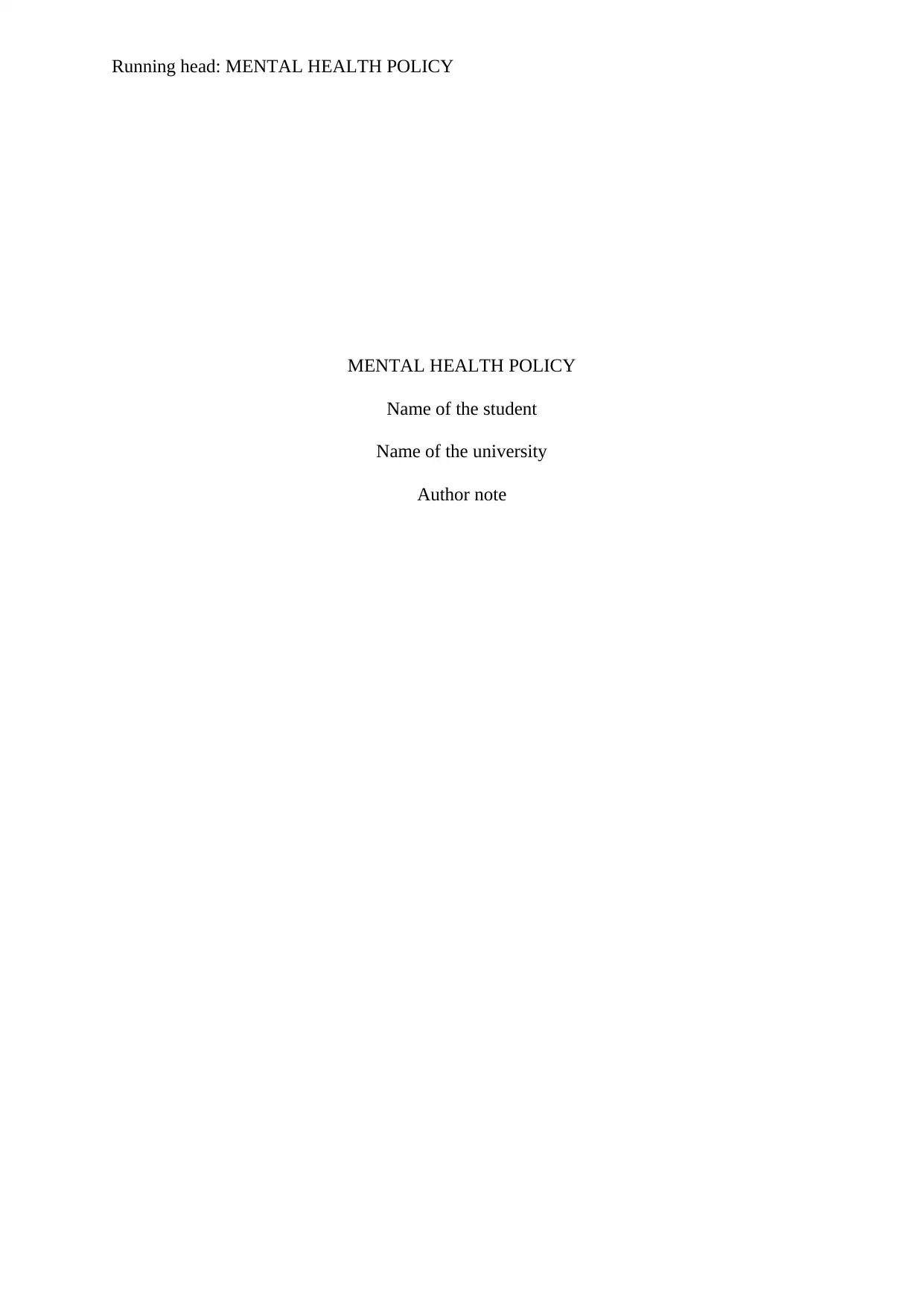
Running head: MENTAL HEALTH POLICY
MENTAL HEALTH POLICY
Name of the student
Name of the university
Author note
MENTAL HEALTH POLICY
Name of the student
Name of the university
Author note
Secure Best Marks with AI Grader
Need help grading? Try our AI Grader for instant feedback on your assignments.
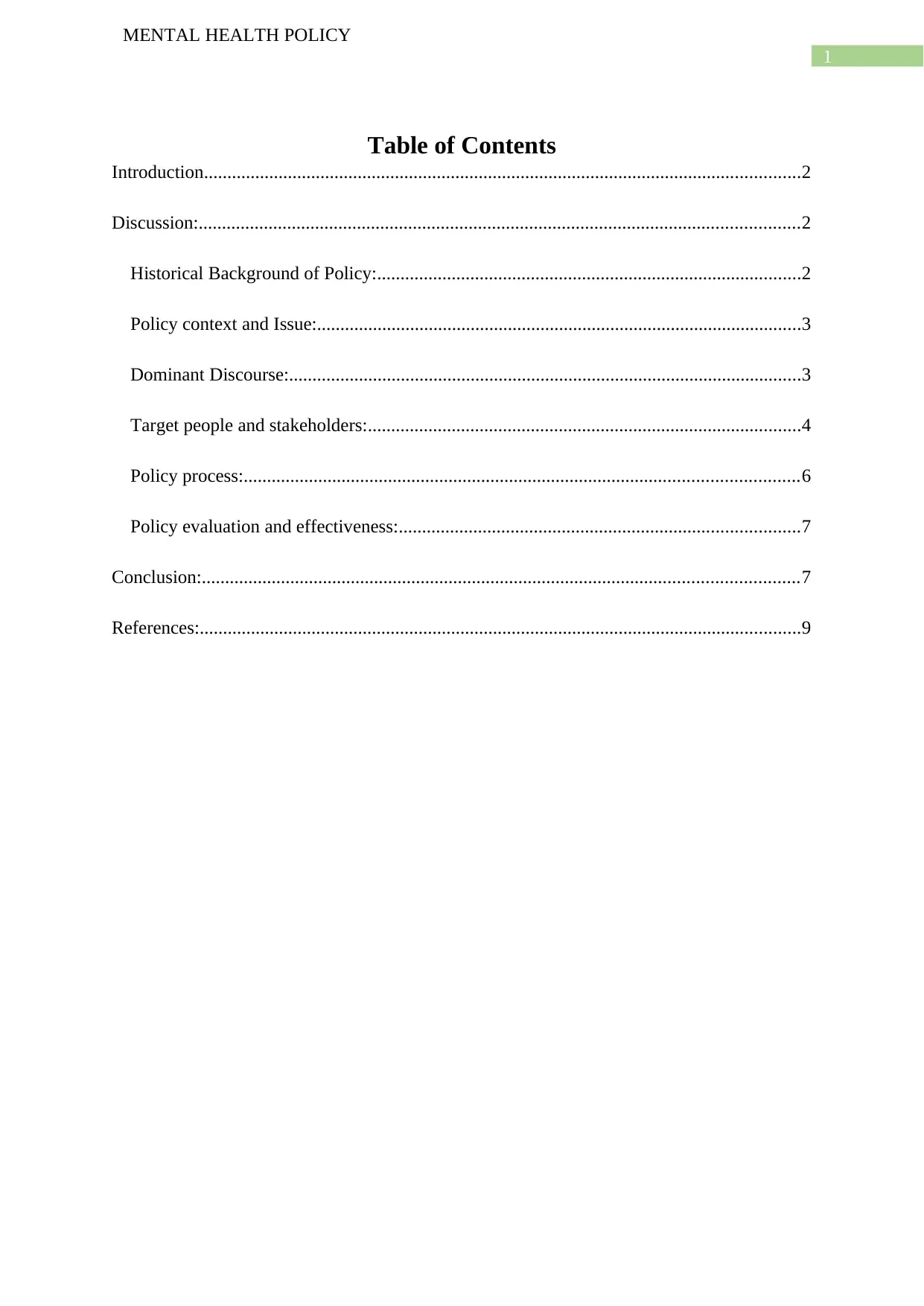
1
MENTAL HEALTH POLICY
Table of Contents
Introduction................................................................................................................................2
Discussion:.................................................................................................................................2
Historical Background of Policy:...........................................................................................2
Policy context and Issue:........................................................................................................3
Dominant Discourse:..............................................................................................................3
Target people and stakeholders:.............................................................................................4
Policy process:.......................................................................................................................6
Policy evaluation and effectiveness:......................................................................................7
Conclusion:................................................................................................................................7
References:.................................................................................................................................9
MENTAL HEALTH POLICY
Table of Contents
Introduction................................................................................................................................2
Discussion:.................................................................................................................................2
Historical Background of Policy:...........................................................................................2
Policy context and Issue:........................................................................................................3
Dominant Discourse:..............................................................................................................3
Target people and stakeholders:.............................................................................................4
Policy process:.......................................................................................................................6
Policy evaluation and effectiveness:......................................................................................7
Conclusion:................................................................................................................................7
References:.................................................................................................................................9
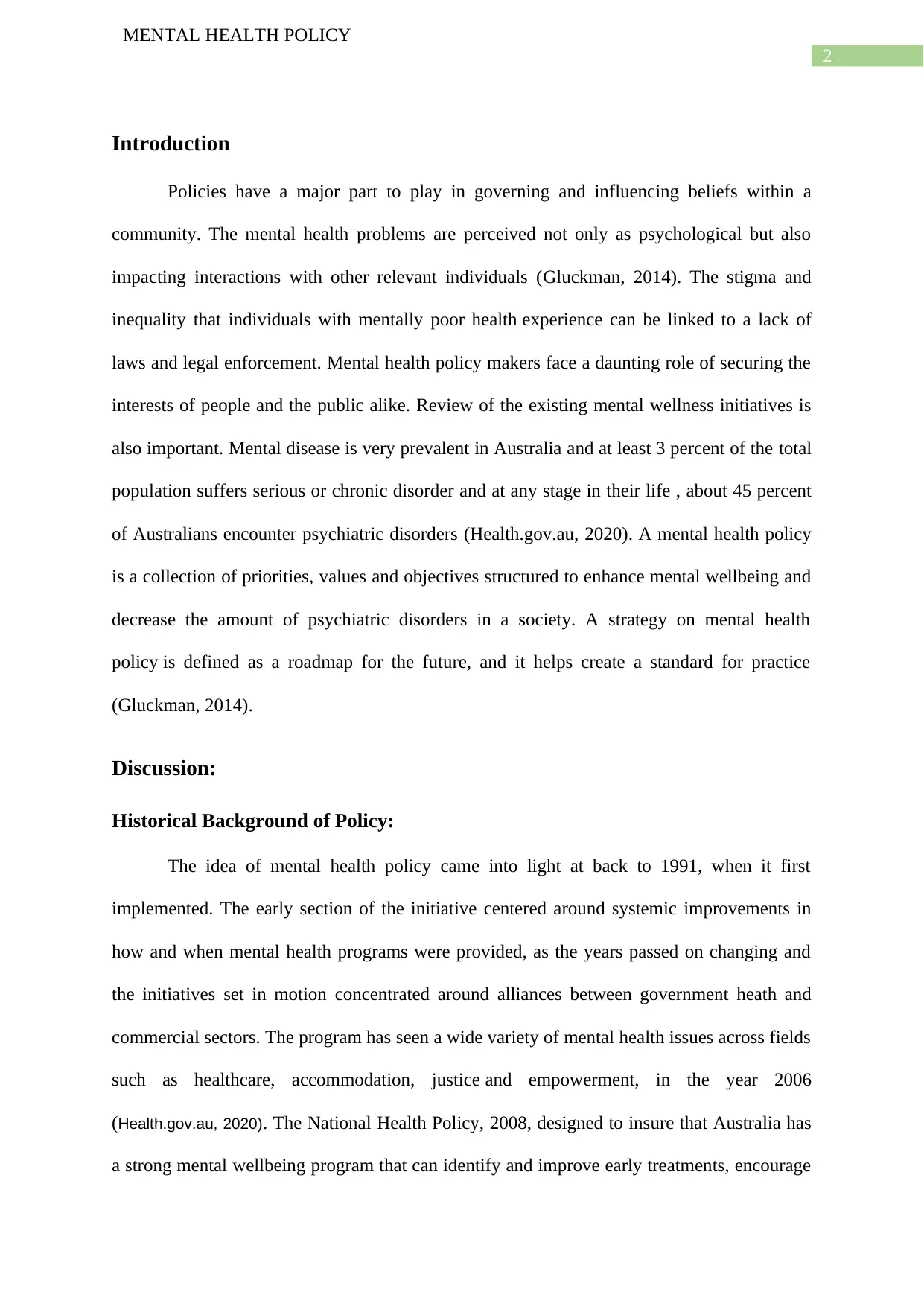
2
MENTAL HEALTH POLICY
Introduction
Policies have a major part to play in governing and influencing beliefs within a
community. The mental health problems are perceived not only as psychological but also
impacting interactions with other relevant individuals (Gluckman, 2014). The stigma and
inequality that individuals with mentally poor health experience can be linked to a lack of
laws and legal enforcement. Mental health policy makers face a daunting role of securing the
interests of people and the public alike. Review of the existing mental wellness initiatives is
also important. Mental disease is very prevalent in Australia and at least 3 percent of the total
population suffers serious or chronic disorder and at any stage in their life , about 45 percent
of Australians encounter psychiatric disorders (Health.gov.au, 2020). A mental health policy
is a collection of priorities, values and objectives structured to enhance mental wellbeing and
decrease the amount of psychiatric disorders in a society. A strategy on mental health
policy is defined as a roadmap for the future, and it helps create a standard for practice
(Gluckman, 2014).
Discussion:
Historical Background of Policy:
The idea of mental health policy came into light at back to 1991, when it first
implemented. The early section of the initiative centered around systemic improvements in
how and when mental health programs were provided, as the years passed on changing and
the initiatives set in motion concentrated around alliances between government heath and
commercial sectors. The program has seen a wide variety of mental health issues across fields
such as healthcare, accommodation, justice and empowerment, in the year 2006
(Health.gov.au, 2020). The National Health Policy, 2008, designed to insure that Australia has
a strong mental wellbeing program that can identify and improve early treatments, encourage
MENTAL HEALTH POLICY
Introduction
Policies have a major part to play in governing and influencing beliefs within a
community. The mental health problems are perceived not only as psychological but also
impacting interactions with other relevant individuals (Gluckman, 2014). The stigma and
inequality that individuals with mentally poor health experience can be linked to a lack of
laws and legal enforcement. Mental health policy makers face a daunting role of securing the
interests of people and the public alike. Review of the existing mental wellness initiatives is
also important. Mental disease is very prevalent in Australia and at least 3 percent of the total
population suffers serious or chronic disorder and at any stage in their life , about 45 percent
of Australians encounter psychiatric disorders (Health.gov.au, 2020). A mental health policy
is a collection of priorities, values and objectives structured to enhance mental wellbeing and
decrease the amount of psychiatric disorders in a society. A strategy on mental health
policy is defined as a roadmap for the future, and it helps create a standard for practice
(Gluckman, 2014).
Discussion:
Historical Background of Policy:
The idea of mental health policy came into light at back to 1991, when it first
implemented. The early section of the initiative centered around systemic improvements in
how and when mental health programs were provided, as the years passed on changing and
the initiatives set in motion concentrated around alliances between government heath and
commercial sectors. The program has seen a wide variety of mental health issues across fields
such as healthcare, accommodation, justice and empowerment, in the year 2006
(Health.gov.au, 2020). The National Health Policy, 2008, designed to insure that Australia has
a strong mental wellbeing program that can identify and improve early treatments, encourage
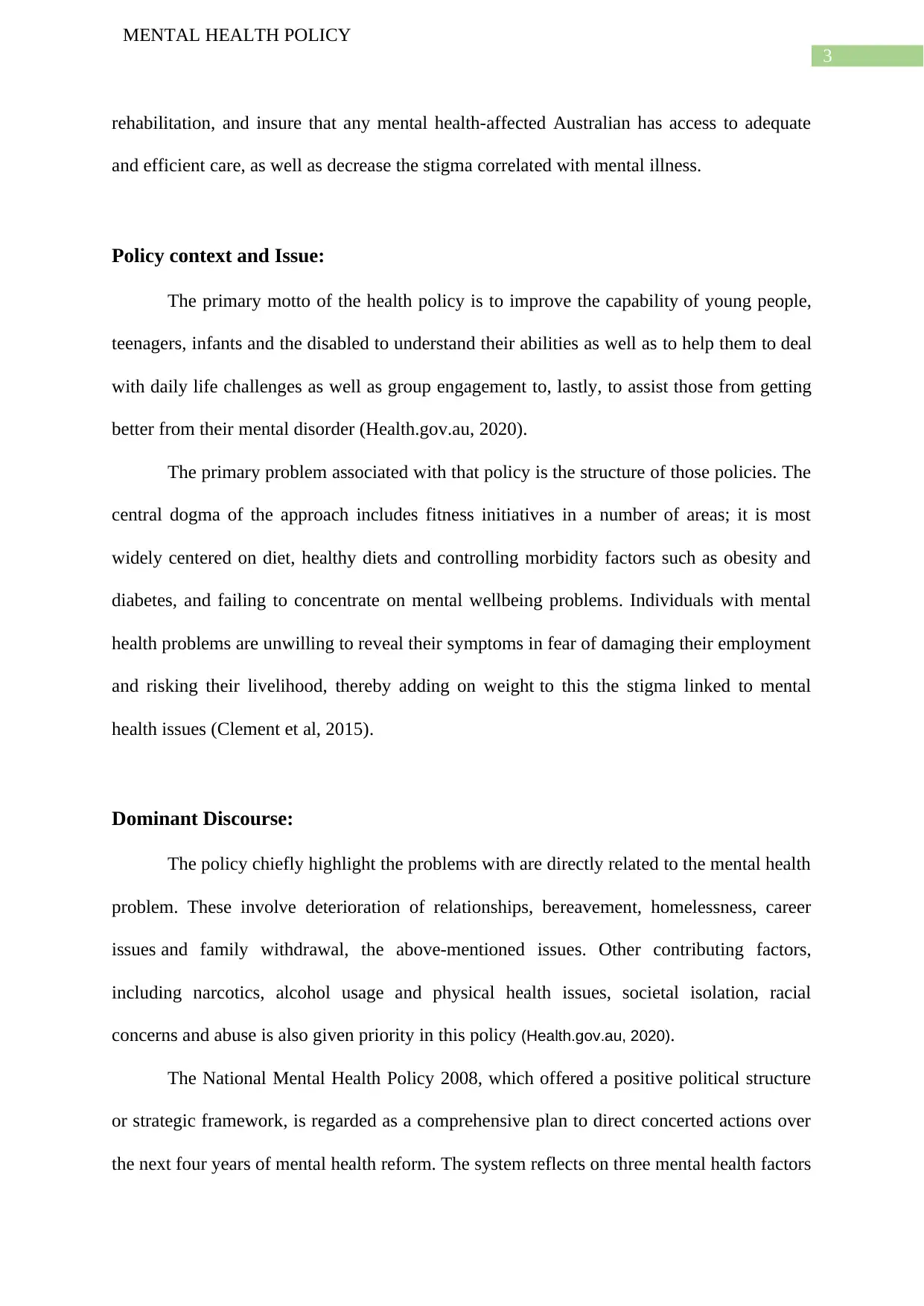
3
MENTAL HEALTH POLICY
rehabilitation, and insure that any mental health-affected Australian has access to adequate
and efficient care, as well as decrease the stigma correlated with mental illness.
Policy context and Issue:
The primary motto of the health policy is to improve the capability of young people,
teenagers, infants and the disabled to understand their abilities as well as to help them to deal
with daily life challenges as well as group engagement to, lastly, to assist those from getting
better from their mental disorder (Health.gov.au, 2020).
The primary problem associated with that policy is the structure of those policies. The
central dogma of the approach includes fitness initiatives in a number of areas; it is most
widely centered on diet, healthy diets and controlling morbidity factors such as obesity and
diabetes, and failing to concentrate on mental wellbeing problems. Individuals with mental
health problems are unwilling to reveal their symptoms in fear of damaging their employment
and risking their livelihood, thereby adding on weight to this the stigma linked to mental
health issues (Clement et al, 2015).
Dominant Discourse:
The policy chiefly highlight the problems with are directly related to the mental health
problem. These involve deterioration of relationships, bereavement, homelessness, career
issues and family withdrawal, the above-mentioned issues. Other contributing factors,
including narcotics, alcohol usage and physical health issues, societal isolation, racial
concerns and abuse is also given priority in this policy (Health.gov.au, 2020).
The National Mental Health Policy 2008, which offered a positive political structure
or strategic framework, is regarded as a comprehensive plan to direct concerted actions over
the next four years of mental health reform. The system reflects on three mental health factors
MENTAL HEALTH POLICY
rehabilitation, and insure that any mental health-affected Australian has access to adequate
and efficient care, as well as decrease the stigma correlated with mental illness.
Policy context and Issue:
The primary motto of the health policy is to improve the capability of young people,
teenagers, infants and the disabled to understand their abilities as well as to help them to deal
with daily life challenges as well as group engagement to, lastly, to assist those from getting
better from their mental disorder (Health.gov.au, 2020).
The primary problem associated with that policy is the structure of those policies. The
central dogma of the approach includes fitness initiatives in a number of areas; it is most
widely centered on diet, healthy diets and controlling morbidity factors such as obesity and
diabetes, and failing to concentrate on mental wellbeing problems. Individuals with mental
health problems are unwilling to reveal their symptoms in fear of damaging their employment
and risking their livelihood, thereby adding on weight to this the stigma linked to mental
health issues (Clement et al, 2015).
Dominant Discourse:
The policy chiefly highlight the problems with are directly related to the mental health
problem. These involve deterioration of relationships, bereavement, homelessness, career
issues and family withdrawal, the above-mentioned issues. Other contributing factors,
including narcotics, alcohol usage and physical health issues, societal isolation, racial
concerns and abuse is also given priority in this policy (Health.gov.au, 2020).
The National Mental Health Policy 2008, which offered a positive political structure
or strategic framework, is regarded as a comprehensive plan to direct concerted actions over
the next four years of mental health reform. The system reflects on three mental health factors
Secure Best Marks with AI Grader
Need help grading? Try our AI Grader for instant feedback on your assignments.
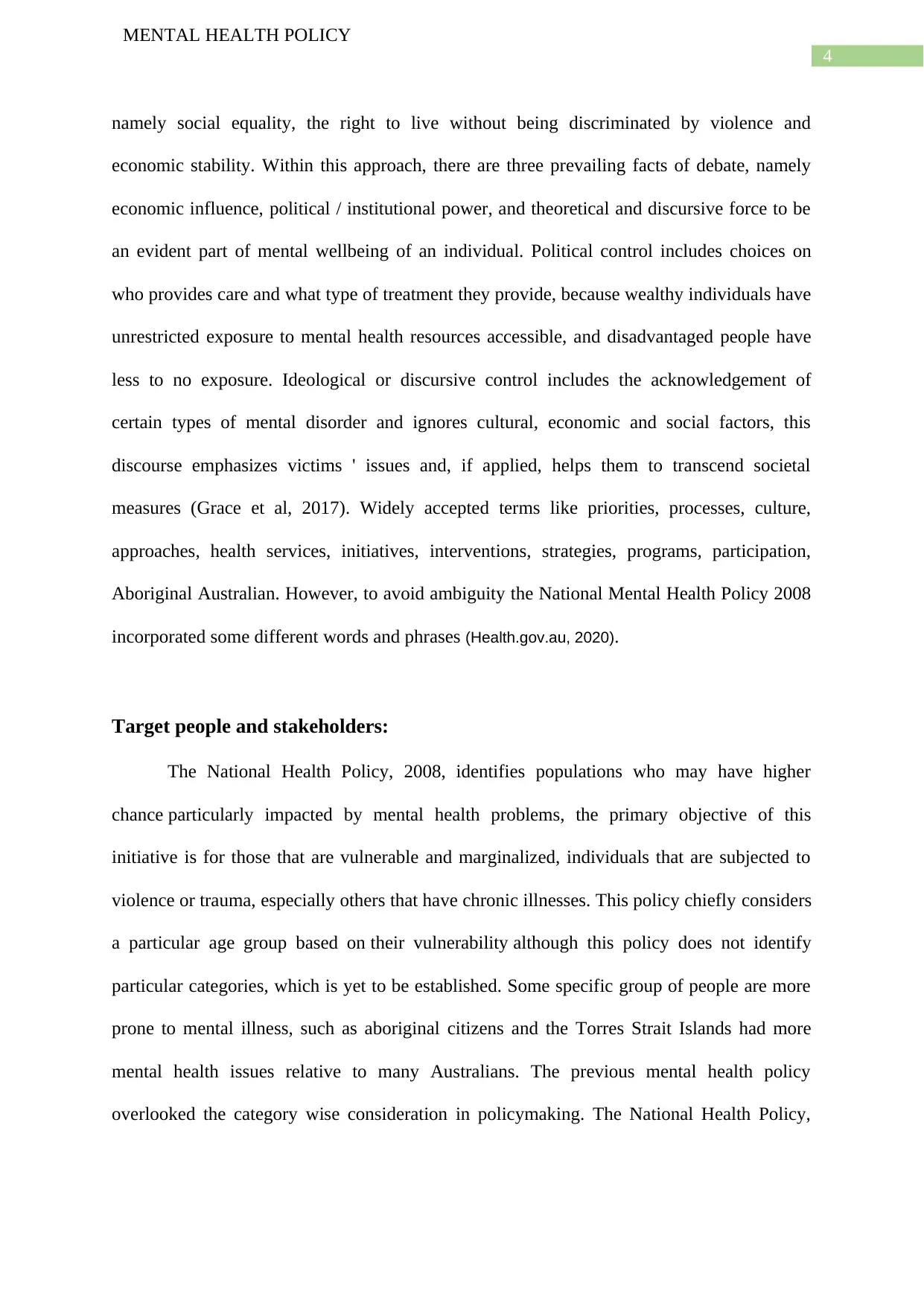
4
MENTAL HEALTH POLICY
namely social equality, the right to live without being discriminated by violence and
economic stability. Within this approach, there are three prevailing facts of debate, namely
economic influence, political / institutional power, and theoretical and discursive force to be
an evident part of mental wellbeing of an individual. Political control includes choices on
who provides care and what type of treatment they provide, because wealthy individuals have
unrestricted exposure to mental health resources accessible, and disadvantaged people have
less to no exposure. Ideological or discursive control includes the acknowledgement of
certain types of mental disorder and ignores cultural, economic and social factors, this
discourse emphasizes victims ' issues and, if applied, helps them to transcend societal
measures (Grace et al, 2017). Widely accepted terms like priorities, processes, culture,
approaches, health services, initiatives, interventions, strategies, programs, participation,
Aboriginal Australian. However, to avoid ambiguity the National Mental Health Policy 2008
incorporated some different words and phrases (Health.gov.au, 2020).
Target people and stakeholders:
The National Health Policy, 2008, identifies populations who may have higher
chance particularly impacted by mental health problems, the primary objective of this
initiative is for those that are vulnerable and marginalized, individuals that are subjected to
violence or trauma, especially others that have chronic illnesses. This policy chiefly considers
a particular age group based on their vulnerability although this policy does not identify
particular categories, which is yet to be established. Some specific group of people are more
prone to mental illness, such as aboriginal citizens and the Torres Strait Islands had more
mental health issues relative to many Australians. The previous mental health policy
overlooked the category wise consideration in policymaking. The National Health Policy,
MENTAL HEALTH POLICY
namely social equality, the right to live without being discriminated by violence and
economic stability. Within this approach, there are three prevailing facts of debate, namely
economic influence, political / institutional power, and theoretical and discursive force to be
an evident part of mental wellbeing of an individual. Political control includes choices on
who provides care and what type of treatment they provide, because wealthy individuals have
unrestricted exposure to mental health resources accessible, and disadvantaged people have
less to no exposure. Ideological or discursive control includes the acknowledgement of
certain types of mental disorder and ignores cultural, economic and social factors, this
discourse emphasizes victims ' issues and, if applied, helps them to transcend societal
measures (Grace et al, 2017). Widely accepted terms like priorities, processes, culture,
approaches, health services, initiatives, interventions, strategies, programs, participation,
Aboriginal Australian. However, to avoid ambiguity the National Mental Health Policy 2008
incorporated some different words and phrases (Health.gov.au, 2020).
Target people and stakeholders:
The National Health Policy, 2008, identifies populations who may have higher
chance particularly impacted by mental health problems, the primary objective of this
initiative is for those that are vulnerable and marginalized, individuals that are subjected to
violence or trauma, especially others that have chronic illnesses. This policy chiefly considers
a particular age group based on their vulnerability although this policy does not identify
particular categories, which is yet to be established. Some specific group of people are more
prone to mental illness, such as aboriginal citizens and the Torres Strait Islands had more
mental health issues relative to many Australians. The previous mental health policy
overlooked the category wise consideration in policymaking. The National Health Policy,
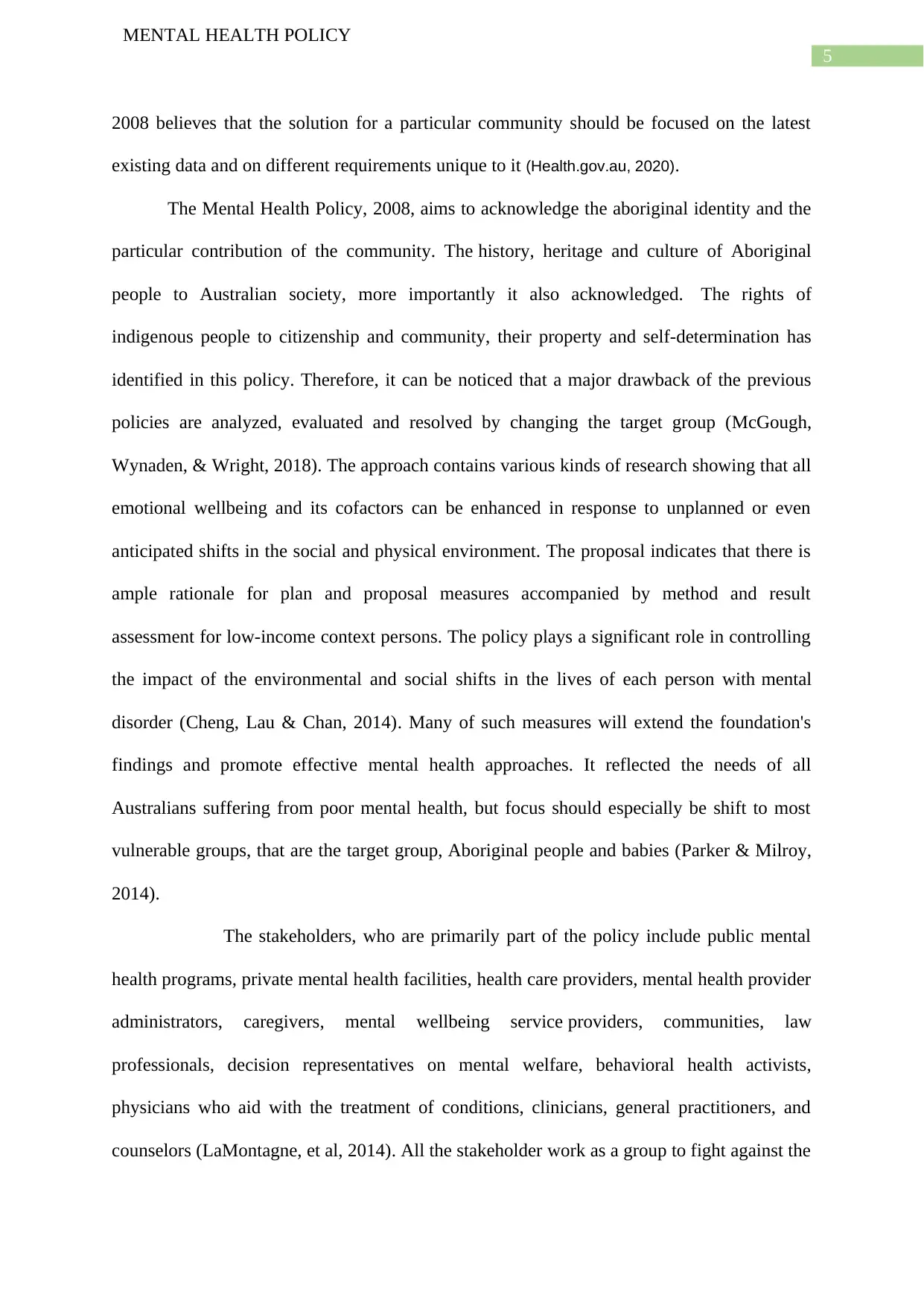
5
MENTAL HEALTH POLICY
2008 believes that the solution for a particular community should be focused on the latest
existing data and on different requirements unique to it (Health.gov.au, 2020).
The Mental Health Policy, 2008, aims to acknowledge the aboriginal identity and the
particular contribution of the community. The history, heritage and culture of Aboriginal
people to Australian society, more importantly it also acknowledged. The rights of
indigenous people to citizenship and community, their property and self-determination has
identified in this policy. Therefore, it can be noticed that a major drawback of the previous
policies are analyzed, evaluated and resolved by changing the target group (McGough,
Wynaden, & Wright, 2018). The approach contains various kinds of research showing that all
emotional wellbeing and its cofactors can be enhanced in response to unplanned or even
anticipated shifts in the social and physical environment. The proposal indicates that there is
ample rationale for plan and proposal measures accompanied by method and result
assessment for low-income context persons. The policy plays a significant role in controlling
the impact of the environmental and social shifts in the lives of each person with mental
disorder (Cheng, Lau & Chan, 2014). Many of such measures will extend the foundation's
findings and promote effective mental health approaches. It reflected the needs of all
Australians suffering from poor mental health, but focus should especially be shift to most
vulnerable groups, that are the target group, Aboriginal people and babies (Parker & Milroy,
2014).
The stakeholders, who are primarily part of the policy include public mental
health programs, private mental health facilities, health care providers, mental health provider
administrators, caregivers, mental wellbeing service providers, communities, law
professionals, decision representatives on mental welfare, behavioral health activists,
physicians who aid with the treatment of conditions, clinicians, general practitioners, and
counselors (LaMontagne, et al, 2014). All the stakeholder work as a group to fight against the
MENTAL HEALTH POLICY
2008 believes that the solution for a particular community should be focused on the latest
existing data and on different requirements unique to it (Health.gov.au, 2020).
The Mental Health Policy, 2008, aims to acknowledge the aboriginal identity and the
particular contribution of the community. The history, heritage and culture of Aboriginal
people to Australian society, more importantly it also acknowledged. The rights of
indigenous people to citizenship and community, their property and self-determination has
identified in this policy. Therefore, it can be noticed that a major drawback of the previous
policies are analyzed, evaluated and resolved by changing the target group (McGough,
Wynaden, & Wright, 2018). The approach contains various kinds of research showing that all
emotional wellbeing and its cofactors can be enhanced in response to unplanned or even
anticipated shifts in the social and physical environment. The proposal indicates that there is
ample rationale for plan and proposal measures accompanied by method and result
assessment for low-income context persons. The policy plays a significant role in controlling
the impact of the environmental and social shifts in the lives of each person with mental
disorder (Cheng, Lau & Chan, 2014). Many of such measures will extend the foundation's
findings and promote effective mental health approaches. It reflected the needs of all
Australians suffering from poor mental health, but focus should especially be shift to most
vulnerable groups, that are the target group, Aboriginal people and babies (Parker & Milroy,
2014).
The stakeholders, who are primarily part of the policy include public mental
health programs, private mental health facilities, health care providers, mental health provider
administrators, caregivers, mental wellbeing service providers, communities, law
professionals, decision representatives on mental welfare, behavioral health activists,
physicians who aid with the treatment of conditions, clinicians, general practitioners, and
counselors (LaMontagne, et al, 2014). All the stakeholder work as a group to fight against the
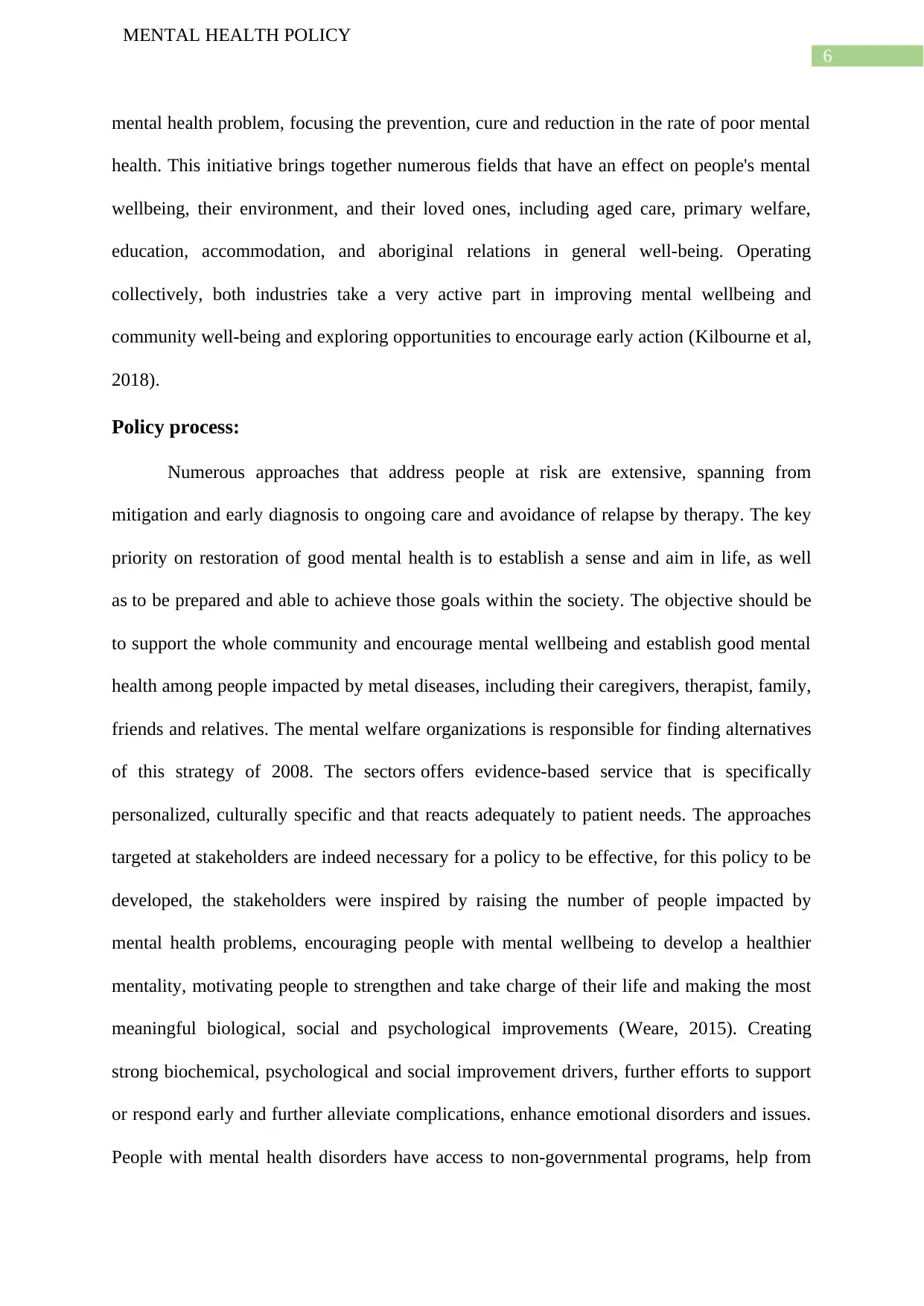
6
MENTAL HEALTH POLICY
mental health problem, focusing the prevention, cure and reduction in the rate of poor mental
health. This initiative brings together numerous fields that have an effect on people's mental
wellbeing, their environment, and their loved ones, including aged care, primary welfare,
education, accommodation, and aboriginal relations in general well-being. Operating
collectively, both industries take a very active part in improving mental wellbeing and
community well-being and exploring opportunities to encourage early action (Kilbourne et al,
2018).
Policy process:
Numerous approaches that address people at risk are extensive, spanning from
mitigation and early diagnosis to ongoing care and avoidance of relapse by therapy. The key
priority on restoration of good mental health is to establish a sense and aim in life, as well
as to be prepared and able to achieve those goals within the society. The objective should be
to support the whole community and encourage mental wellbeing and establish good mental
health among people impacted by metal diseases, including their caregivers, therapist, family,
friends and relatives. The mental welfare organizations is responsible for finding alternatives
of this strategy of 2008. The sectors offers evidence-based service that is specifically
personalized, culturally specific and that reacts adequately to patient needs. The approaches
targeted at stakeholders are indeed necessary for a policy to be effective, for this policy to be
developed, the stakeholders were inspired by raising the number of people impacted by
mental health problems, encouraging people with mental wellbeing to develop a healthier
mentality, motivating people to strengthen and take charge of their life and making the most
meaningful biological, social and psychological improvements (Weare, 2015). Creating
strong biochemical, psychological and social improvement drivers, further efforts to support
or respond early and further alleviate complications, enhance emotional disorders and issues.
People with mental health disorders have access to non-governmental programs, help from
MENTAL HEALTH POLICY
mental health problem, focusing the prevention, cure and reduction in the rate of poor mental
health. This initiative brings together numerous fields that have an effect on people's mental
wellbeing, their environment, and their loved ones, including aged care, primary welfare,
education, accommodation, and aboriginal relations in general well-being. Operating
collectively, both industries take a very active part in improving mental wellbeing and
community well-being and exploring opportunities to encourage early action (Kilbourne et al,
2018).
Policy process:
Numerous approaches that address people at risk are extensive, spanning from
mitigation and early diagnosis to ongoing care and avoidance of relapse by therapy. The key
priority on restoration of good mental health is to establish a sense and aim in life, as well
as to be prepared and able to achieve those goals within the society. The objective should be
to support the whole community and encourage mental wellbeing and establish good mental
health among people impacted by metal diseases, including their caregivers, therapist, family,
friends and relatives. The mental welfare organizations is responsible for finding alternatives
of this strategy of 2008. The sectors offers evidence-based service that is specifically
personalized, culturally specific and that reacts adequately to patient needs. The approaches
targeted at stakeholders are indeed necessary for a policy to be effective, for this policy to be
developed, the stakeholders were inspired by raising the number of people impacted by
mental health problems, encouraging people with mental wellbeing to develop a healthier
mentality, motivating people to strengthen and take charge of their life and making the most
meaningful biological, social and psychological improvements (Weare, 2015). Creating
strong biochemical, psychological and social improvement drivers, further efforts to support
or respond early and further alleviate complications, enhance emotional disorders and issues.
People with mental health disorders have access to non-governmental programs, help from
Paraphrase This Document
Need a fresh take? Get an instant paraphrase of this document with our AI Paraphraser
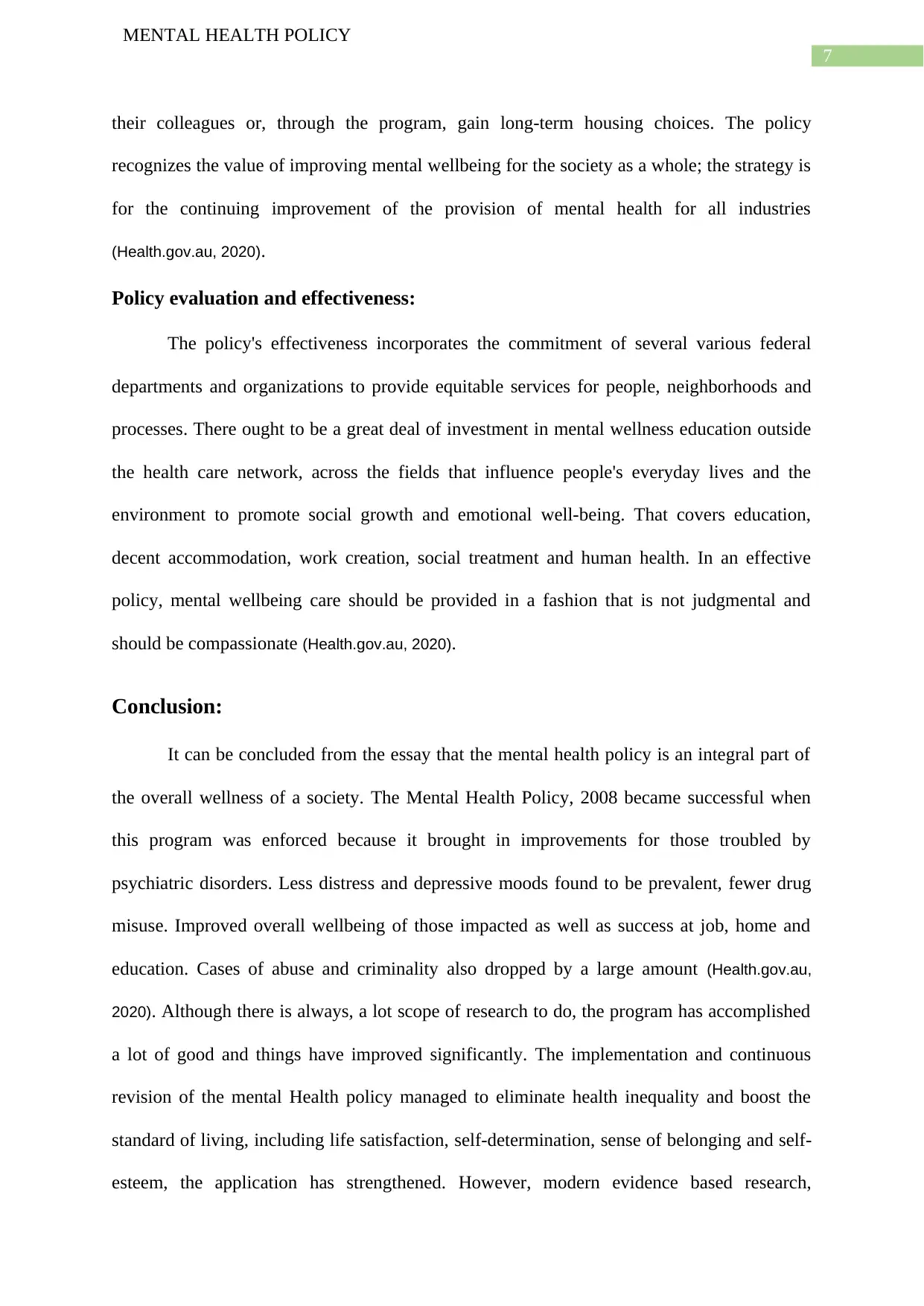
7
MENTAL HEALTH POLICY
their colleagues or, through the program, gain long-term housing choices. The policy
recognizes the value of improving mental wellbeing for the society as a whole; the strategy is
for the continuing improvement of the provision of mental health for all industries
(Health.gov.au, 2020).
Policy evaluation and effectiveness:
The policy's effectiveness incorporates the commitment of several various federal
departments and organizations to provide equitable services for people, neighborhoods and
processes. There ought to be a great deal of investment in mental wellness education outside
the health care network, across the fields that influence people's everyday lives and the
environment to promote social growth and emotional well-being. That covers education,
decent accommodation, work creation, social treatment and human health. In an effective
policy, mental wellbeing care should be provided in a fashion that is not judgmental and
should be compassionate (Health.gov.au, 2020).
Conclusion:
It can be concluded from the essay that the mental health policy is an integral part of
the overall wellness of a society. The Mental Health Policy, 2008 became successful when
this program was enforced because it brought in improvements for those troubled by
psychiatric disorders. Less distress and depressive moods found to be prevalent, fewer drug
misuse. Improved overall wellbeing of those impacted as well as success at job, home and
education. Cases of abuse and criminality also dropped by a large amount (Health.gov.au,
2020). Although there is always, a lot scope of research to do, the program has accomplished
a lot of good and things have improved significantly. The implementation and continuous
revision of the mental Health policy managed to eliminate health inequality and boost the
standard of living, including life satisfaction, self-determination, sense of belonging and self-
esteem, the application has strengthened. However, modern evidence based research,
MENTAL HEALTH POLICY
their colleagues or, through the program, gain long-term housing choices. The policy
recognizes the value of improving mental wellbeing for the society as a whole; the strategy is
for the continuing improvement of the provision of mental health for all industries
(Health.gov.au, 2020).
Policy evaluation and effectiveness:
The policy's effectiveness incorporates the commitment of several various federal
departments and organizations to provide equitable services for people, neighborhoods and
processes. There ought to be a great deal of investment in mental wellness education outside
the health care network, across the fields that influence people's everyday lives and the
environment to promote social growth and emotional well-being. That covers education,
decent accommodation, work creation, social treatment and human health. In an effective
policy, mental wellbeing care should be provided in a fashion that is not judgmental and
should be compassionate (Health.gov.au, 2020).
Conclusion:
It can be concluded from the essay that the mental health policy is an integral part of
the overall wellness of a society. The Mental Health Policy, 2008 became successful when
this program was enforced because it brought in improvements for those troubled by
psychiatric disorders. Less distress and depressive moods found to be prevalent, fewer drug
misuse. Improved overall wellbeing of those impacted as well as success at job, home and
education. Cases of abuse and criminality also dropped by a large amount (Health.gov.au,
2020). Although there is always, a lot scope of research to do, the program has accomplished
a lot of good and things have improved significantly. The implementation and continuous
revision of the mental Health policy managed to eliminate health inequality and boost the
standard of living, including life satisfaction, self-determination, sense of belonging and self-
esteem, the application has strengthened. However, modern evidence based research,
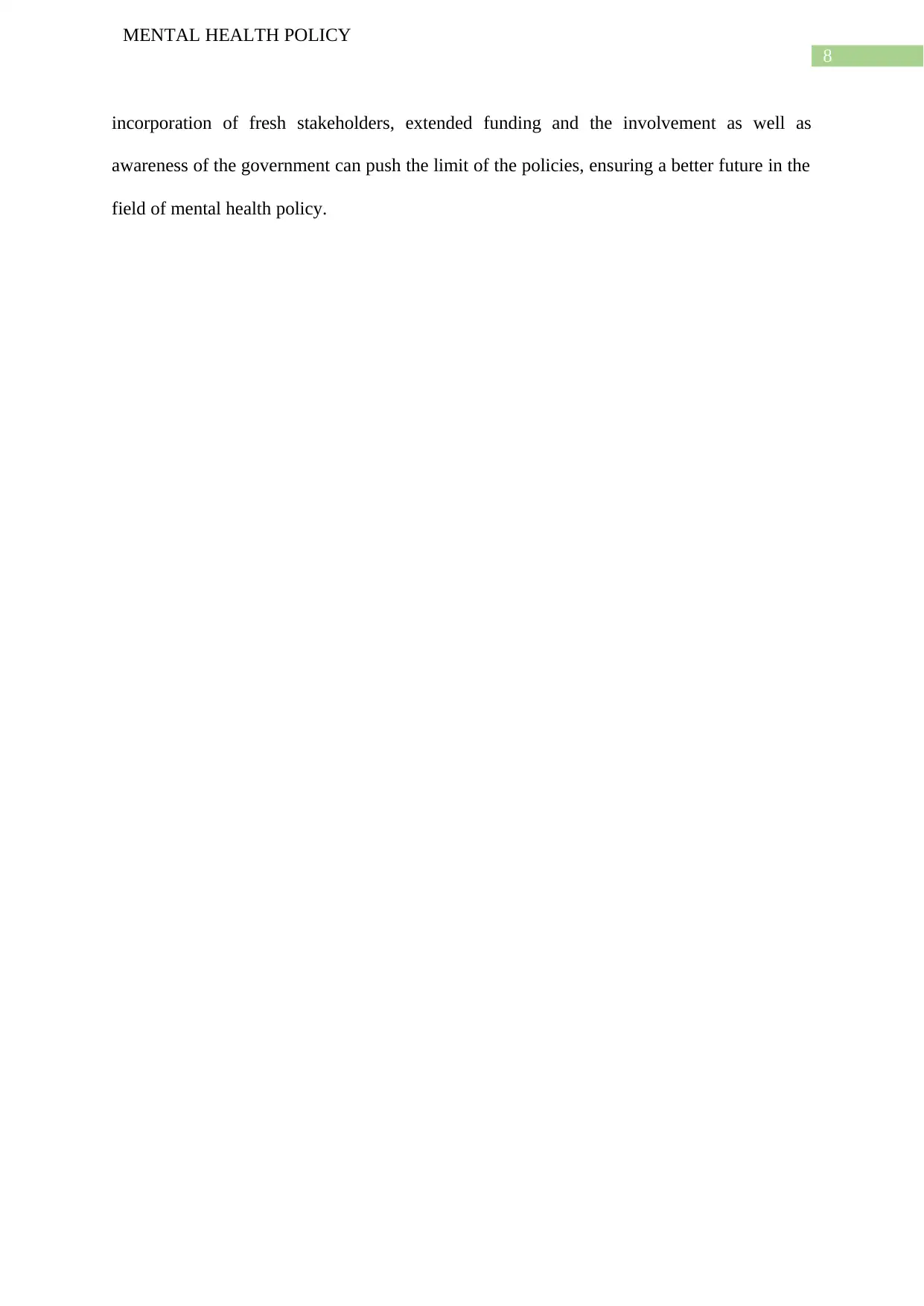
8
MENTAL HEALTH POLICY
incorporation of fresh stakeholders, extended funding and the involvement as well as
awareness of the government can push the limit of the policies, ensuring a better future in the
field of mental health policy.
MENTAL HEALTH POLICY
incorporation of fresh stakeholders, extended funding and the involvement as well as
awareness of the government can push the limit of the policies, ensuring a better future in the
field of mental health policy.
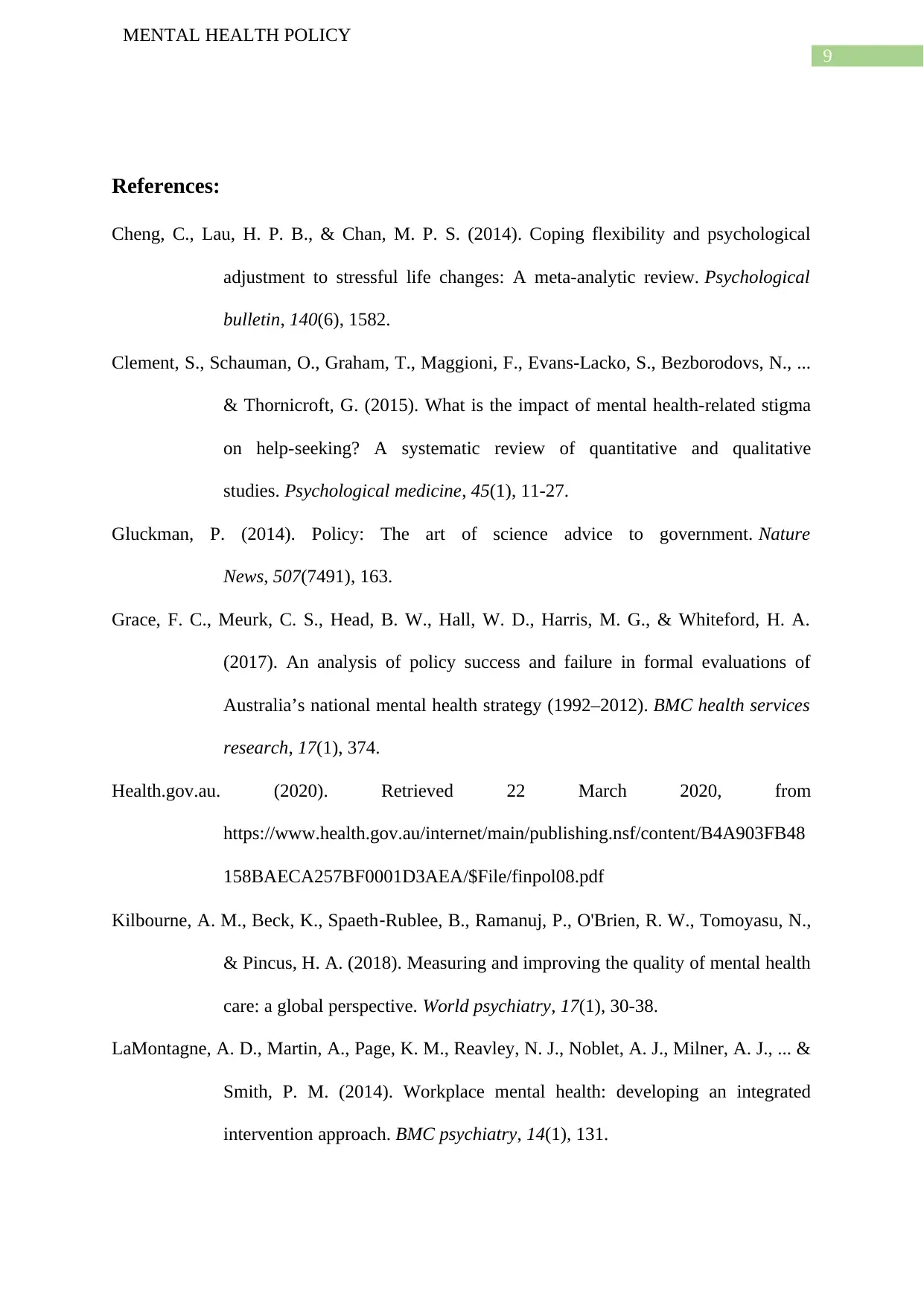
9
MENTAL HEALTH POLICY
References:
Cheng, C., Lau, H. P. B., & Chan, M. P. S. (2014). Coping flexibility and psychological
adjustment to stressful life changes: A meta-analytic review. Psychological
bulletin, 140(6), 1582.
Clement, S., Schauman, O., Graham, T., Maggioni, F., Evans-Lacko, S., Bezborodovs, N., ...
& Thornicroft, G. (2015). What is the impact of mental health-related stigma
on help-seeking? A systematic review of quantitative and qualitative
studies. Psychological medicine, 45(1), 11-27.
Gluckman, P. (2014). Policy: The art of science advice to government. Nature
News, 507(7491), 163.
Grace, F. C., Meurk, C. S., Head, B. W., Hall, W. D., Harris, M. G., & Whiteford, H. A.
(2017). An analysis of policy success and failure in formal evaluations of
Australia’s national mental health strategy (1992–2012). BMC health services
research, 17(1), 374.
Health.gov.au. (2020). Retrieved 22 March 2020, from
https://www.health.gov.au/internet/main/publishing.nsf/content/B4A903FB48
158BAECA257BF0001D3AEA/$File/finpol08.pdf
Kilbourne, A. M., Beck, K., Spaeth‐Rublee, B., Ramanuj, P., O'Brien, R. W., Tomoyasu, N.,
& Pincus, H. A. (2018). Measuring and improving the quality of mental health
care: a global perspective. World psychiatry, 17(1), 30-38.
LaMontagne, A. D., Martin, A., Page, K. M., Reavley, N. J., Noblet, A. J., Milner, A. J., ... &
Smith, P. M. (2014). Workplace mental health: developing an integrated
intervention approach. BMC psychiatry, 14(1), 131.
MENTAL HEALTH POLICY
References:
Cheng, C., Lau, H. P. B., & Chan, M. P. S. (2014). Coping flexibility and psychological
adjustment to stressful life changes: A meta-analytic review. Psychological
bulletin, 140(6), 1582.
Clement, S., Schauman, O., Graham, T., Maggioni, F., Evans-Lacko, S., Bezborodovs, N., ...
& Thornicroft, G. (2015). What is the impact of mental health-related stigma
on help-seeking? A systematic review of quantitative and qualitative
studies. Psychological medicine, 45(1), 11-27.
Gluckman, P. (2014). Policy: The art of science advice to government. Nature
News, 507(7491), 163.
Grace, F. C., Meurk, C. S., Head, B. W., Hall, W. D., Harris, M. G., & Whiteford, H. A.
(2017). An analysis of policy success and failure in formal evaluations of
Australia’s national mental health strategy (1992–2012). BMC health services
research, 17(1), 374.
Health.gov.au. (2020). Retrieved 22 March 2020, from
https://www.health.gov.au/internet/main/publishing.nsf/content/B4A903FB48
158BAECA257BF0001D3AEA/$File/finpol08.pdf
Kilbourne, A. M., Beck, K., Spaeth‐Rublee, B., Ramanuj, P., O'Brien, R. W., Tomoyasu, N.,
& Pincus, H. A. (2018). Measuring and improving the quality of mental health
care: a global perspective. World psychiatry, 17(1), 30-38.
LaMontagne, A. D., Martin, A., Page, K. M., Reavley, N. J., Noblet, A. J., Milner, A. J., ... &
Smith, P. M. (2014). Workplace mental health: developing an integrated
intervention approach. BMC psychiatry, 14(1), 131.
Secure Best Marks with AI Grader
Need help grading? Try our AI Grader for instant feedback on your assignments.
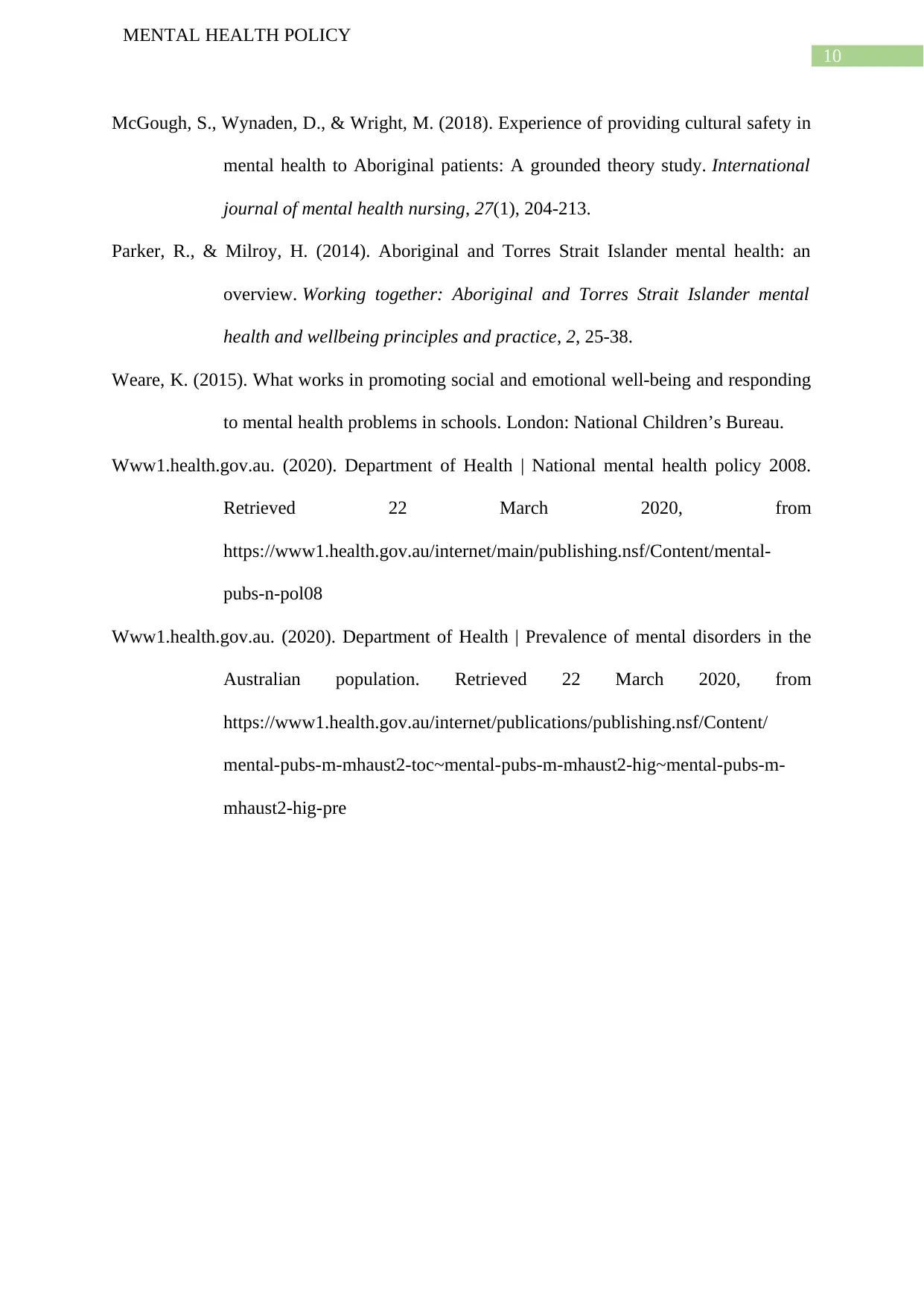
10
MENTAL HEALTH POLICY
McGough, S., Wynaden, D., & Wright, M. (2018). Experience of providing cultural safety in
mental health to Aboriginal patients: A grounded theory study. International
journal of mental health nursing, 27(1), 204-213.
Parker, R., & Milroy, H. (2014). Aboriginal and Torres Strait Islander mental health: an
overview. Working together: Aboriginal and Torres Strait Islander mental
health and wellbeing principles and practice, 2, 25-38.
Weare, K. (2015). What works in promoting social and emotional well-being and responding
to mental health problems in schools. London: National Children’s Bureau.
Www1.health.gov.au. (2020). Department of Health | National mental health policy 2008.
Retrieved 22 March 2020, from
https://www1.health.gov.au/internet/main/publishing.nsf/Content/mental-
pubs-n-pol08
Www1.health.gov.au. (2020). Department of Health | Prevalence of mental disorders in the
Australian population. Retrieved 22 March 2020, from
https://www1.health.gov.au/internet/publications/publishing.nsf/Content/
mental-pubs-m-mhaust2-toc~mental-pubs-m-mhaust2-hig~mental-pubs-m-
mhaust2-hig-pre
MENTAL HEALTH POLICY
McGough, S., Wynaden, D., & Wright, M. (2018). Experience of providing cultural safety in
mental health to Aboriginal patients: A grounded theory study. International
journal of mental health nursing, 27(1), 204-213.
Parker, R., & Milroy, H. (2014). Aboriginal and Torres Strait Islander mental health: an
overview. Working together: Aboriginal and Torres Strait Islander mental
health and wellbeing principles and practice, 2, 25-38.
Weare, K. (2015). What works in promoting social and emotional well-being and responding
to mental health problems in schools. London: National Children’s Bureau.
Www1.health.gov.au. (2020). Department of Health | National mental health policy 2008.
Retrieved 22 March 2020, from
https://www1.health.gov.au/internet/main/publishing.nsf/Content/mental-
pubs-n-pol08
Www1.health.gov.au. (2020). Department of Health | Prevalence of mental disorders in the
Australian population. Retrieved 22 March 2020, from
https://www1.health.gov.au/internet/publications/publishing.nsf/Content/
mental-pubs-m-mhaust2-toc~mental-pubs-m-mhaust2-hig~mental-pubs-m-
mhaust2-hig-pre
1 out of 11
Your All-in-One AI-Powered Toolkit for Academic Success.
+13062052269
info@desklib.com
Available 24*7 on WhatsApp / Email
![[object Object]](/_next/static/media/star-bottom.7253800d.svg)
Unlock your academic potential
© 2024 | Zucol Services PVT LTD | All rights reserved.


